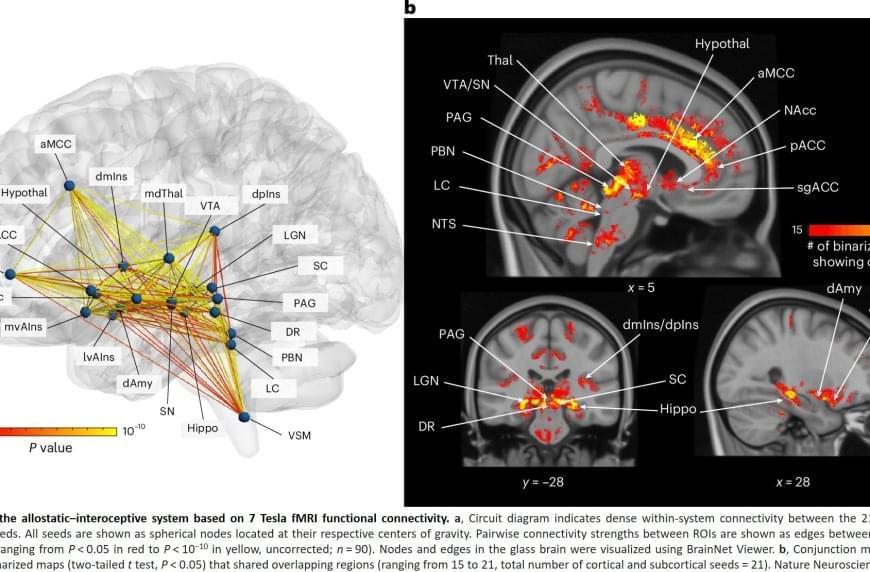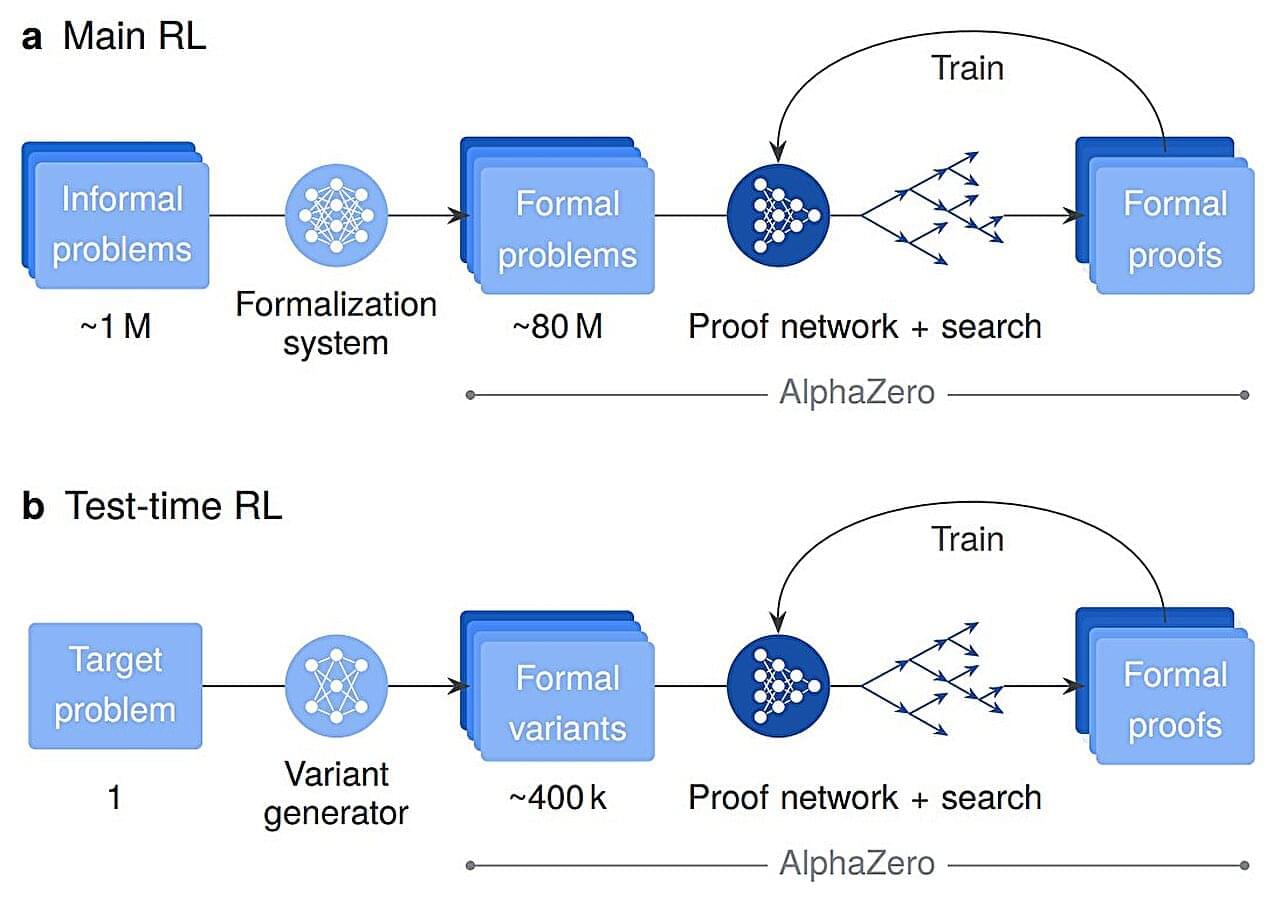Berkshire Hathaway revealed a $4.3 billion stake in Google parent Alphabet and further reduced its stake in Apple , detailing its equity portfolio for the last time before Warren Buffett ends his 60-year run as chief executive officer.



They also used a recently validated map of deep brain areas. This in vivo atlas, Brainstem Navigator, maps the regions involved in regulating the autonomic, immune and endocrine systems.
The authors analytic approach was guided by decades of basic research that has identified two main brain pathways in mammals: one set of pathways (allostatic) that sends signals from the brain to control the body’s organs, and the other set (interoceptive) that sends signals from the body to the brain, informing it about what’s happening inside us.
The findings replicated and expanded on their previous 3 Tesla work, confirming nearly all the direct connections identified in non-human mammals: 100% of those between cortical areas and 96% of those linking subcortical areas to both cortical and other subcortical areas. As expected, the authors found two-way connections between the brain areas that help manage the body’s needs (like the anterior cingulate cortex) and the areas that sense what’s happening inside the body (like the posterior insula). This means these regions communicate back and forth, helping the brain predict and regulate what the body needs.
Mounting evidence suggests that one of the brain’s central roles is to anticipate and meet the body’s energy needs. The findings place the monitoring and regulation of the body’s needs at the functional core of the human brain, showing the close connection between mental and physical health.
Previous studies in both animal models and humans have pointed to the existence of a distributed system in the brain that helps it anticipate and prepare for the body’s energy needs — a process called allostasis — as well as monitor the sensory conditions inside the body, known as interoception.
In an earlier study using 3 Tesla fMRI, the team mapped a network supporting allostasis and interoception in the human brain, but the comparatively limited spatial resolution and sensitivity of the 3 Tesla technology made it difficult to fully capture the system’s smaller structures in the brainstem, which are known to play a key role in these processes.

The world’s first automatic and adaptive, dual-mode light-emitting diode (LED)-based optical wireless power transmission system, that operates seamlessly under both dark and bright lighting conditions, has been developed by scientists at Science Tokyo. The system, along with artificial intelligence-powered image recognition, can efficiently power multiple devices in order without interruption. Because it is LED-based, it offers a low-cost and safe solution ideal for building sustainable indoor Internet of Things infrastructure.
With the rapid development of Internet of Things (IoT), the demand for efficient and flexible power solutions is also increasing. Traditional power delivery methods, such as batteries and cable connections, have many drawbacks. Batteries need frequent charging and replacement, while cables restrict device mobility.
Optical wireless power transmission (OWPT) is an emerging technology that can address these limitations. In OWPT, energy is transmitted through free space, without physical wires, by converting electricity to light, transmitting it, and then reconverting light back into electrical power using photovoltaic (PV) receivers.

A joint research team from the Institute of Geochemistry of the Chinese Academy of Sciences (IGCAS) and Shandong University has for the first time identified crystalline hematite (α-Fe2O3) and maghemite (γ-Fe2O3) formed by a major impact event in lunar soil samples retrieved by China’s Chang’e-6 mission from the South Pole–Aitken (SPA) Basin. This finding, published in Science Advances on November 14, provides direct sample-based evidence of highly oxidized materials on the lunar surface.
Redox reactions are a fundamental component of planetary formation and evolution. Nevertheless, scientific studies have shown that neither the oxygen fugacity of the lunar interior nor the lunar surface environment favors oxidation. Consistent with this, multivalent iron on the moon primarily exists in its ferrous (Fe2+) and metallic (Fe0) states, suggesting an overall reduced state. However, with further lunar exploration, recent orbital remote sensing studies using visible-near-infrared spectroscopy have suggested the widespread presence of hematite in the moon’s high-latitude regions.
Furthermore, earlier research on Chang’e-5 samples first revealed impact-generated sub-micron magnetite (Fe3O4) and evidence of Fe3+ in impact glasses. These results indicate that localized oxidizing environments on the moon existed during lunar surface modification processes driven by external impacts.

At the 2024 International Mathematical Olympiad (IMO), one competitor did so well that it would have been awarded the Silver Prize, except for one thing: it was an AI system. This was the first time AI had achieved a medal-level performance in the competition’s history. In a paper published in the journal Nature, researchers detail the technology behind this remarkable achievement.
The AI is AlphaProof, a sophisticated program developed by Google DeepMind that learns to solve complex mathematical problems. The achievement at the IMO was impressive enough, but what really makes AlphaProof special is its ability to find and correct errors. While large language models (LLMs) can solve math problems, they often can’t guarantee the accuracy of their solutions. There may be hidden flaws in their reasoning.
AlphaProof is different because its answers are always 100% correct. That’s because it uses a specialized software environment called Lean (originally developed by Microsoft Research) that acts like a strict teacher verifying every logical step. This means the computer itself verifies answers, so its conclusions are trustworthy.

A collaborative European research team led by physicists from Slovak Academy of Sciences has theorized a new approach to control spin currents in graphene by coupling it to a ferroelectric In2Se3 monolayer. Using first-principles and tight-binding simulations, the researcher showed that the ferroelectric switching of In2Se3 can reverse the direction of the spin current in graphene acting as an electrical spin switch. This discovery offers a novel pathway toward energy-efficient, nonvolatile, and magnet-free spintronic devices, marking a key step toward the fabrication of next-generation spin-based logic and memory systems to control spin textures.
The findings are published in the journal Materials Futures.

Harvard Medical School researchers report that higher day-to-day “trigger surprisal” scores were associated with migraine attacks over the next 12 and 24 hours. In this cohort, higher surprisal scores aligned with greater odds of a headache attack, even after accounting for recent headache history and fluctuations in daily experience.
Migraine management often revolves around trying to identify and control conditions that might trigger them. From food and drink and environmental exposures to physiological and psychological stressors, it is a crowded landscape of potential trigger suspects. Individuals attempting to match migraine attack timing to these suspected triggers rely on memory and a self-selected list of candidates rather than controlled experimental designs.
In the study, “Information-Theoretic Trigger Surprisal and Future Headache Activity,” published in JAMA Network Open, researchers conducted a cohort study to evaluate the association between surprise and future headache attacks.

People can think, behave and function very differently. These observed differences are known to be the result of complex interactions between genetics, neurobiological processes and life experiences.
Understanding the factors underlying individual differences in behavior, cognition and mental health is a key objective of numerous psychology and behavioral science studies. One approach to explore these factors entails examining patterns of brain activity that spontaneously emerge when individuals are awake but not engaged in any tasks.
Earlier research aimed at uncovering individual-specific brain activity patterns has primarily looked at the neural fluctuations indicating communication or coupling between distant brain regions. In contrast, very few studies have focused on intra-regional neural dynamics (i.e., fluctuations that take place within individual brain regions over time).

Robots could soon be able to autonomously complete search and rescue missions, inspections, complex maintenance operations and various other real-world tasks. To do this, however, they should be able to smoothly navigate unknown and complex environments without breaking down or getting stuck, which would require human intervention.
Most autonomous navigation systems rely on global positioning systems (GPS), which can provide information about where a robot is located within a map. In many environments, however, including caves, unstructured spaces and collapsed buildings, GPS systems either do not work or become unreliable.
Researchers at Beijing Institute of Technology recently developed a new nature-inspired system that could improve robot navigation in unstructured and complex environments, without relying on GPS technology. Their proposed framework— outlined in a paper set to be published in Cell Press and currently available on the SSRN preprint server—is inspired by three distinct biological navigation strategies observed in insects, birds and rodents.

A McGill University-led research team has demonstrated the feasibility of a sustainable and cost-effective way to desalinate seawater. The method—thermally driven reverse osmosis (TDRO)—uses a piston-based system powered by low-grade heat from solar thermal, geothermal heat and other sources of renewable energy to produce fresh water.
Though previous research showed promise, this study is the first to analyze TDRO’s thermodynamic limits. The results have brought researchers closer to realizing the technology which could improve access to water and increase the sustainability of infrastructure.
“Most desalination is done by reverse osmosis, which uses electricity to drive water through a membrane,” said Jonathan Maisonneuve, study co-author and Associate Professor of Bioresource Engineering.